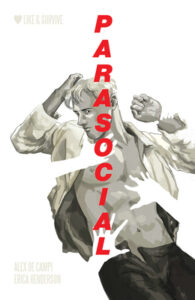It should give you some idea of how expertly inhabited this male-protagonist-driven graphic novel is that I was genuinely surprised that the author and artist are both women.
 The story itself takes place just as pandemic lockdowns are easing in the USA. People are going to fan conventions again, tho with greater precautions than before, of course. One of these people is C-List TV star Luke Indiana, famous for his cult hit role on the sci-fi TV show Rogue Nebula. He’s a featured celebrity guest, sitting on panels, doing meet and greets, and taking photos with fans. As with any job, there are high points and low points, even before taking into account the less than ideal state of his own personal and professional lives.
The story itself takes place just as pandemic lockdowns are easing in the USA. People are going to fan conventions again, tho with greater precautions than before, of course. One of these people is C-List TV star Luke Indiana, famous for his cult hit role on the sci-fi TV show Rogue Nebula. He’s a featured celebrity guest, sitting on panels, doing meet and greets, and taking photos with fans. As with any job, there are high points and low points, even before taking into account the less than ideal state of his own personal and professional lives.
Things only start to go really bad when he’s on the road away from the con. His phone battery is dying, he can’t find a charger cable, and he’s not 100% sure how to get back to the friends’ house where he’s staying. When a semi runs him off the road, he thinks he’s hit rock bottom. But a fan shows up to make sure he’s okay, a fan who’s perhaps been chattering a little too much online about “accidentally” running into him after the con. Their roadside conversation sparks a cat and mouse game of blood and fire that could end up claiming more than just one victim.
This was a really thoughtful update of the celebrity vs stalker plot arguably brought to its peak with Stephen King’s Misery (full disclosure: I never read it or watched the movie based on it, as Misery seemed, with my apologies to King fans, very obvious.) Parasocial chooses to use an actor instead of a writer because, as Alex de Campi’s afterword incisively observes, writers tend to over-romanticize themselves as “poor misunderstood angel[s]”. Actors, on the other hand, make their livings by pretending emotions they don’t actually feel. And in the age of social media, encouraging parasocial relationships, like Luke does with his fans before one of them takes it way too fucking far, is career de rigeur.
The genius of Parasocial lies in the way that it makes both Luke and his stalker seem desperately sympathetic. Neither is a great person but both are going through some really shitty things, and coping by using fantasy is hardly a sin. The ending is surprisingly satisfying: not exactly happy, not exactly bittersweet, but filled with hope for better.
Erica Henderson does some really terrific things with her art, bringing to mind Matt Kindt’s work on MIND MGMT tho with less surrealism. Her choices with depicting the characters’ moods are impressive, as is her expert use of panels and social-media-esque spreads.
The Parasocial graphic novel might not be a long read but it is an impactful one. Recommended.
Parasocial by Alex de Campi & Erica Henderson was published October 3 2023 by Image Comics and is available from all good booksellers, including
